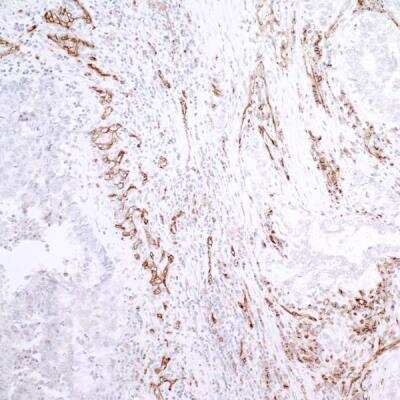CD31/PECAM-1 Antibody Best Seller
Novus Biologicals, part of Bio-Techne | Catalog # NB100-2284

Key Product Details
Species Reactivity
Validated:
Human, Mouse, Rat, Porcine, Canine
Cited:
Human, Mouse, Rat, Mammal
Applications
Validated:
Immunocytochemistry/ Immunofluorescence, Immunohistochemistry, Immunohistochemistry-Frozen, Immunohistochemistry-Paraffin, Western Blot
Cited:
Flow Cytometry, IF/IHC, Immunocytochemistry/ Immunofluorescence, Immunofluorescence, Immunohistochemistry, Immunohistochemistry-Frozen, Immunohistochemistry-Paraffin, Western Blot
Label
Unconjugated
Antibody Source
Polyclonal Rabbit IgG
Concentration
0.1 mg/ml
Product Specifications
Immunogen
The immunogen recognized by this CD31/PECAM-1 Antibody maps to a region between residue 700 and the C-terminus (residue 738) of human CD31 using the numbering given in entry NP_000433.2 (Gene ID 5175).
Reactivity Notes
Mouse reactivity reported in scientific literature (PMID: 23317813). Rat reactivity reported in scientific literature (PMID: 29960821). Porcine reactivity reported from a verified customer review. Canine reactivity reported from a verified customer review.
Clonality
Polyclonal
Host
Rabbit
Isotype
IgG
Theoretical MW
82.5 kDa.
Disclaimer note: The observed molecular weight of the protein may vary from the listed predicted molecular weight due to post translational modifications, post translation cleavages, relative charges, and other experimental factors.
Disclaimer note: The observed molecular weight of the protein may vary from the listed predicted molecular weight due to post translational modifications, post translation cleavages, relative charges, and other experimental factors.
Scientific Data Images for CD31/PECAM-1 Antibody
Immunohistological Staining of CD31/PECAM-1 in Paraffin Embedded Human Breast Carcinoma
FFPE section of human breast carcinoma. Antibody: Affinity purified rabbit CD31/PECAM-1 Antibody (NB100-2284) used at a dilution of 1:100. Detection: Red-fluorescent goat anti-rabbit IgG-Hilyte PlusTM 555Immunohistological Detection of CD31/PECAM-1 in Paraffin Embedded Rat Liver
Staining of CD31/PECAM-1 in Rat Liver sample. IHC-P image submitted by a verified customer review.Staining of CD31/PECAM-1 in Paraffin Embedded Human Lung Adenocarcinoma
Human lung adenocarcinoma using. Antibody at 1:100 with citrate epitope retrieval at pH 6.0.Applications for CD31/PECAM-1 Antibody
Application
Recommended Usage
Immunocytochemistry/ Immunofluorescence
1:50 - 1:500
Immunohistochemistry
1:100 - 1:500
Immunohistochemistry-Frozen
1:10 - 1:500
Immunohistochemistry-Paraffin
1:100 - 1:500
Western Blot
1:100 - 1:2000
Application Notes
For IHC-P: Epitope exposure is recommended, with citrate buffer will enhance staining. In some cases, the antibody may be diluted further than indicated. IHC-Fr, WB reactivity reported in scientific literature (PMID:23317813). ICC/IF reactivity reported in scientific literature (PMID: 27328066).
Reviewed Applications
Read 8 reviews rated 4.8 using NB100-2284 in the following applications:
Formulation, Preparation, and Storage
Purification
Immunogen affinity purified
Formulation
TBS, 0.1% BSA
Preservative
0.09% Sodium Azide
Concentration
0.1 mg/ml
Shipping
The product is shipped with polar packs. Upon receipt, store it immediately at the temperature recommended below.
Stability & Storage
Store at 4C. Do not freeze.
Background: CD31/PECAM-1
PECAM's intracellular cytoplasmic domain consists of a sequence of 118 amino acids and contains serine and tyrosine (also referred to as immunoreceptor tyrosine-based inhibitory motifs-ITIMs) residues, which may be phosphorylated upon cellular stimulation (3). ITIMs are phosphorylated by Src-family kinases and non-Src family kinases (e.g., Csk), leading to a conformational change which supports interactions with Src homology 2 (SH2) domain containing proteins such as protein-tyrosine phosphatase, SHP-2 (1,2). Formation of SHP-2/PECAM-1 complexes induces endothelial cell migration through the dephosphorylation of focal adhesion kinase and regulation of RhoA activity (1). Signaling downstream of ITIM tyrosine phosphorylations also plays a role in PECAM's anti-apoptotic activity, a function which is independent of its interaction with SHP-2. In platelets and leukocytes, phosphorylation of PECAM's cytosolic domain is inhibitory, preventing their activation.
References
1. Lertkiatmongkol, P., Liao, D., Mei, H., Hu, Y., & Newman, P. J. (2016). Endothelial functions of PECAM-1 (CD31). Current Opinion in Hematology. https://doi.org/10.1097/MOH.0000000000000239.Endothelial
2. Privratsky, J. R., & Newman, P. J. (2014). PECAM-1: Regulator of endothelial junctional integrity. Cell and Tissue Research. https://doi.org/10.1007/s00441-013-1779-3
3. Newman, P. J., & Newman, D. K. (2003). Signal transduction pathways mediated by PECAM-1: New roles for an old molecule in platelet and vascular cell biology. Arteriosclerosis, Thrombosis, and Vascular Biology. https://doi.org/10.1161/01.ATV.0000071347.69358.D9
Long Name
Platelet Endothelial Cell Adhesion Molecule 1
Alternate Names
CD31, EndoCAM, PECA1, PECAM-1, PECAM1
Entrez Gene IDs
5175 (Human)
Gene Symbol
PECAM1
UniProt
Additional CD31/PECAM-1 Products
Product Documents for CD31/PECAM-1 Antibody
Product Specific Notices for CD31/PECAM-1 Antibody
This product is for research use only and is not approved for use in humans or in clinical diagnosis. Primary Antibodies are guaranteed for 1 year from date of receipt.
Loading...
Loading...
Loading...
Loading...
Loading...










![Immunohistochemistry: CD31/PECAM-1 Antibody [NB100-2284] - CD31/PECAM-1 Antibody](https://resources.bio-techne.com/images/products/nb100-2284_rabbit-polyclonal-cd31-pecam-1-antibody-271220231253332.jpg)
![Immunohistochemistry: Rabbit Polyclonal CD31/PECAM-1 Antibody [NB100-2284] CD31/PECAM-1 Antibody](https://resources.bio-techne.com/images/products/antibody/nb100-2284_rabbit-polyclonal-cd31-pecam-1-antibody-immunohistochemistry-49202494658..jpg)
![Immunohistochemistry: CD31/PECAM-1 Antibody [NB100-2284] - CD31/PECAM-1 Antibody](https://resources.bio-techne.com/images/products/nb100-2284_rabbit-cd31-pecam-1-pab-310202415371939.jpg)
![Immunohistochemistry: CD31/PECAM-1 Antibody [NB100-2284] - CD31/PECAM-1 Antibody](https://resources.bio-techne.com/images/products/nb100-2284_rabbit-cd31-pecam-1-pab-3102024153970.jpg)
![Immunohistochemistry: CD31/PECAM-1 Antibody [NB100-2284] - CD31/PECAM-1 Antibody](https://resources.bio-techne.com/images/products/nb100-2284_rabbit-cd31-pecam-1-pab-31020241535625.jpg)
![Western Blot: CD31/PECAM-1 Antibody [NB100-2284] - CD31/PECAM-1 Antibody](https://resources.bio-techne.com/images/products/nb100-2284_rabbit-cd31-pecam-1-pab-310202415541933.jpg)
![Immunocytochemistry/ Immunofluorescence: CD31/PECAM-1 Antibody [NB100-2284] - CD31/PECAM-1 Antibody](https://resources.bio-techne.com/images/products/nb100-2284_rabbit-cd31-pecam-1-pab-3102024165737.jpg)
![Immunohistochemistry: CD31/PECAM-1 Antibody [NB100-2284] - CD31/PECAM-1 Antibody](https://resources.bio-techne.com/images/products/nb100-2284_rabbit-cd31-pecam-1-pab-31020241612684.jpg)
![Immunocytochemistry/ Immunofluorescence: CD31/PECAM-1 Antibody [NB100-2284] - CD31/PECAM-1 Antibody](https://resources.bio-techne.com/images/products/nb100-2284_rabbit-cd31-pecam-1-pab-310202415532085.jpg)
![Immunohistochemistry-Paraffin: Rabbit Polyclonal CD31/PECAM-1 Antibody [NB100-2284] CD31/PECAM-1 Antibody](https://resources.bio-techne.com/images/products/antibody/nb100-2284_rabbit-polyclonal-cd31-pecam-1-antibody-immunohistochemistry-paraffin-203202593412..jpg)